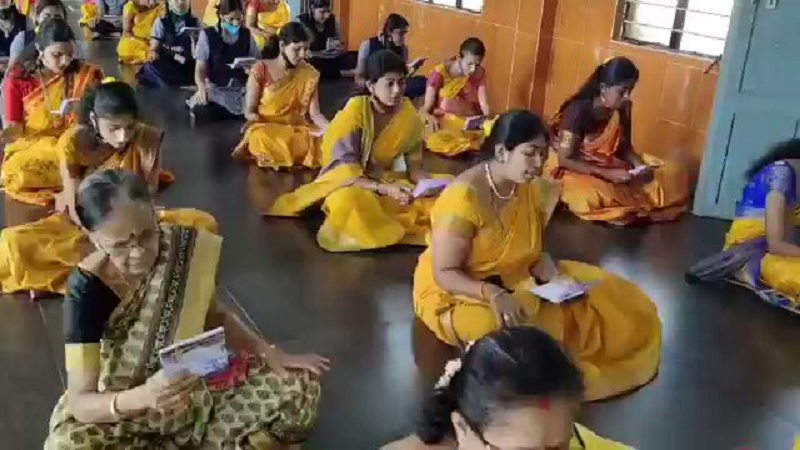
Image Courtesy:flipboard.com
While the Karnataka High Court continues to discuss the presence of religious clothing, especially hijab, in educational institutions, the state’s colleges and even schools are erupting with news of authorities demanding that girl students remove their hijab inside classrooms.
The anger on social media has now taken a new course with discussions of whether non-Islamic religions also have a presence in educational institutions. This gathered steam after a video shared by Times of India reporter Shreyas H. S. of Karkala’s Jaycees English Medium School (JEMS) students chanting the Hanuman Chalisa, started trending on Twitter on February 16, 2022.
While #Muslim students in #BJP ruled #Karnataka are targeted for wearing #Hijab,the teachers and kids of Jaycees English Medium School at Karkala chant Mantras. In this #school every day Hanuman Chalisa is read in fully display of #Hinduism pic.twitter.com/2Lb4eqYi7K
— Shreyas HS (@shreyas_ToI) February 15, 2022
The video shows many women devotees sitting at the front of a hall for the bhajan while students at the back sing along. The tweet draws comparison of this with the hijab controversy pointing out that the bhajan is sung in “full display of Hinduism”.
This argument does not hold well, considering the school in question is a private school. But it drives the conversation towards the larger question of the presence of religion in educational institutions.
JEMS’ secular attitude
While there is no official website of the JEMS, scattered information across the internet says that it is a one-of-a-kind school that first introduced English as a medium in the taluka. Founded in 1980 by the Karkala Junior Chamber under the leadership of K. P. Shenoy, the school started off in leased premises at the Sri Ananthashayana Temple.
Eventually, it managed enough funds to build its independent building near the Swaraj Maidan on a hill that allows a view of a Bahubali statue and Chathurmukha Basathi, a Jain temple. Its back-to-school video showed a pandit maha-acharya visiting the school-opening as an important guest.
However, the school is a private co-ed institution, that as per the YouTube videos shared by its teachers, invests in the secular image by celebrating non-Hindu events like Christmas. Largely, the school promotes the image of pushing its motto “Live the Dreams and Build the Future”.
Secular image of public and private institutions
Owing to its private funding, the school does not make for a good comparison with the PU colleges that have come under the public eye recently. Still, the discussion points towards other government-funded institutions that do prioritise Hindu festivals or rituals.
For example, the dominance of Hindu festivals in terms of number and length when schools list out annual holidays. Non-minority schools in India prioritise Hindu events in their calendar.
Similarly, on February 25, 2021, the Centre introduced the national-level voluntary online exam on “cow science” to teach students and general public about the benefits of the indigenous cow. Cows are sacred animals in Hinduism. Thus, the existence of such a course caters to the beliefs of a particular community, rather than people at large. Yet, the incident received mild response from the public. Meanwhile, controversy over a hijab – a scarf – has taken the nation by storm.
The root of the hijab controversy
Currently, the hijab row is often diverting attention from even election-related news at times. By February 15, school children were told to take off their hijab causing havoc at a time when final exams are fast approaching.
Still, since the garment relates specifically to Muslim women, many journalists like Rana Ayyub, Faye D’Souza and RJ Sayema argued that the matter of a Muslim woman’s autonomy to wear what they want. The protesting students have also argued the same. The older women were trolled on social media later for exercising this same right to choice and not donning a hijab.
The matter also fits into the Hate Pyramid that tracks the course of hate from societal prejudices to all-out genocide. With the violence in some districts of Karnataka, the hijab row has already reached the fourth stage of the pyramid “Violence” while other areas like Madhya Pradesh, Pondicherry and Uttar Pradesh are entering the third stage of educational exclusion of Islamic women for wearing scarves.
Therefore, the conversation on social media and in the public’s eye is now shifting away from the underlying issues of Islamophobia and women’s autonomy, subjects that actually need greater attention and discussion.
Related:
Hijab ban case: Hijab in line with freedom of expression, submits petitioner
Hijab ban: Multiple Dimensions
Hijab controversy now hits schools!
How can a College Committee make decision on ‘public order’: Petitioners at Hijab Ban hearing
Hijab Case: Will action be taken against Karanataka BJP for sharing details of minor Muslim students?